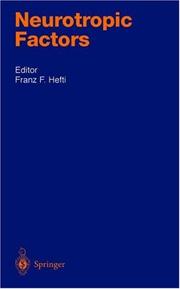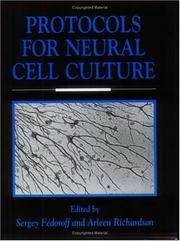| Listing 1 - 10 of 13 | << page >> |
Sort by
|

ISBN: 0198546874 Year: 1995 Publisher: Oxford Oxford university press
Abstract | Keywords | Export | Availability | Bookmark
 Loading...
Loading...Choose an application
- Reference Manager
- EndNote
- RefWorks (Direct export to RefWorks)
Book
ISBN: 1837693137 Year: 2023 Publisher: London, England : IntechOpen,
Abstract | Keywords | Export | Availability | Bookmark
 Loading...
Loading...Choose an application
- Reference Manager
- EndNote
- RefWorks (Direct export to RefWorks)
As a member of the protein family known as neurotrophins, brain-derived neurotrophic factor (BDNF) plays a crucial role in supporting healthy brain function, which includes synaptic plasticity, cellular differentiation, learning, and the survival of nerve cells. Neuronal plasticity refers to the nervous system's ability to adapt and respond to environmental conditions, involving various structural and functional mechanisms that can lead to changes in neural circuits, the formation of new synapses, and the generation of fresh neurons. BDNF has emerged as a significant regulator of neuronal plasticity. It is worth noting that the pathophysiological processes underlying central nervous system disorders and neuropsychiatric conditions such as depression, anxiety, autism, and schizophrenia, as well as neurodegenerative diseases like Parkinson's and Alzheimer's, are influenced by BDNF. Due to its robust neuroprotective properties and recently discovered anti-inflammatory and anti-apoptotic characteristics, BDNF has long been considered a potential candidate for preventing neurodegeneration. In the context of autism spectrum disorder, BDNF holds great promise as a central focus for therapeutic efforts. Its significance extends to the field of spinal cord injury, where it assumes a multifaceted role in the intricate pathophysiological processes at play. BDNF functions as a catalyst for the growth of axons, a crucial step in the restoration of the nervous system following damage. In the context of sepsis, research into the potential of BDNF's anti-inflammatory properties to mitigate organ damage is quite noteworthy. Additionally, current findings suggest that combining exercise with vitamin D may offer a promising approach to increase BDNF levels and improve brain health. This book presents comprehensive information on BDNF and its role in promoting neuroprotection. The chapters offer insights into recent developments, molecular principles, and innovative therapeutic approaches for neurodegenerative disorders and brain health.
Book
ISBN: 9783642451058 Year: 2014 Publisher: Berlin : Springer,
Abstract | Keywords | Export | Availability | Bookmark
 Loading...
Loading...Choose an application
- Reference Manager
- EndNote
- RefWorks (Direct export to RefWorks)
Neurons --- Neurotrophic functions. --- Nervous system --- Physiology. --- Diseases.
Book
ISBN: 0080279864 0080288456 Year: 1982 Publisher: Oxford Pergamon
Abstract | Keywords | Export | Availability | Bookmark
 Loading...
Loading...Choose an application
- Reference Manager
- EndNote
- RefWorks (Direct export to RefWorks)
Metabolism --- Neurotrophic functions --- Biological control systems --- Regulation --- Congresses --- Congresses --- Congresses
Book
ISBN: 3319078275 3319078267 1322136971 Year: 2014 Publisher: Cham : Springer International Publishing : Imprint: Springer,
Abstract | Keywords | Export | Availability | Bookmark
 Loading...
Loading...Choose an application
- Reference Manager
- EndNote
- RefWorks (Direct export to RefWorks)
This book gives an overview of various interactomes involved in dorsal ventral (DV) and anterior posterior (AP) guidance, their mechanisms of action, subcellular localizations, and functional roles. It will provide readers a better understanding of the development of the nervous system, which in turn will help to find cures to various neural and other disorders. In nematodes there are two types of guidance systems, including DV and AP guidance. The signaling process that guides the growth cones along the DV axis has remained intact in both vertebrates and invertebrates. The adaptor protein UNC-53 appears to play a part in migration along the AP axis in both worms and their human homologs. “Neuron Navigators” (NAV) are also involved in nervous system development .
Molecular neurobiology. --- Neurons --- Biomedicine. --- Growth. --- Neurotrophic functions --- Molecular neurology --- Nervous system --- Molecular biology --- Neurobiology --- Molecular aspects --- Neurosciences. --- Neurobiology. --- Neurology. --- Medicine --- Neuropsychiatry --- Neurosciences --- Neural sciences --- Neurological sciences --- Neuroscience --- Medical sciences --- Diseases --- Neurology .

ISBN: 3540646140 3642641822 3642599206 Year: 1998 Volume: 134 Publisher: Berlin ; Heidelberg ; New York Springer Verlag
Abstract | Keywords | Export | Availability | Bookmark
 Loading...
Loading...Choose an application
- Reference Manager
- EndNote
- RefWorks (Direct export to RefWorks)
The pharmacology of neurotrophic factors is part of the general field called neuroprotection or neurodegeneration, which has emerged during the past two decades. This new broad research area has identified molecular mechanisms that regulate the morphological plasticity of the nervous system and, in con sequence, discovered novel pharmacological approaches to manipulate these processes in disease states. The new, structural neuropharmacology as de scribed in this volume attempts to regulate the anatomic aspects of the nervous system and is perhaps comparable to hardware manipulation in computer systems. In contrast, classical neuropharmacology identified multiple ways to modify the function of existing synapses or ion channels in the nervous system, comparable to software manipulations in the computer field. The pharmacol ogy of neurotrophic factor is at an early stage and has not produced any major drugs yet. However, the first quintessential clinical trials have been carried out in the past two years or are currently in progress. Rapid further advances can be expected. The discovery of nerve growth factor (NGF), the first protein known to promote survival and growth of nerve cells, led to the discovery of a family of related proteins, the neurotrophins and their receptors. This concept was generalized to incorporate many other protein families that are included in the functional definition of neurotrophic factors, i. e. , proteins able to regulate survival and differentiation of neurons.
Facteurs de croissance nerveux --- Fonctions neurotrophiques --- Nerfs--Facteurs de croissance --- Nerve growth factor --- Neurotrope functies --- Neurotrophic functions --- Zenuwen--Groeifactoren --- Nerve Growth Factors --- Nerve growth factor. --- Neurotrophic functions. --- Nervous System Diseases --- Nervous system --- Pharmacology. --- Therapeutic use. --- Therapy. --- Diseases. --- Diseases --- Neurosciences. --- Neurology . --- Pharmacology/Toxicology. --- Neurology. --- Medicine --- Neuropsychiatry --- Neural sciences --- Neurological sciences --- Neuroscience --- Medical sciences --- Drug effects --- Medical pharmacology --- Chemicals --- Chemotherapy --- Drugs --- Pharmacy --- Physiological effect --- Neurophysiology --- Medical neurology --- Nerves --- Neurologic disorders --- Neurological disorders --- Neuropathology --- Neurology

ISBN: 1280613599 9786610613595 0387313893 0387260676 1489983449 Year: 2006 Publisher: New York : Springer,
Abstract | Keywords | Export | Availability | Bookmark
 Loading...
Loading...Choose an application
- Reference Manager
- EndNote
- RefWorks (Direct export to RefWorks)
This text provides a comprehensive summary of research and findings that have lead to the current understanding of the subventricular zones. It provides an overview of the roles of subventricular zones in normal development and in disease and a foundation from which current and future studies can be evaluated.
Developmental neurobiology. --- Neurons --- Growth. --- Neurotrophic functions --- Developmental neurology --- Neurogenesis --- Developmental biology --- Embryology --- Neurobiology --- Nervous system --- Neuroplasticity --- Evolution --- Neurosciences. --- Reproductive Medicine. --- Human reproduction --- Human reproductive health --- Human reproductive medicine --- Reproductive medicine --- Health --- Neural sciences --- Neurological sciences --- Neuroscience --- Medical sciences --- Health aspects --- Reproductive medicine.

ISBN: 1489990224 038733128X 9786610816583 1280816589 0387685618 Year: 2007 Publisher: New York : Springer,
Abstract | Keywords | Export | Availability | Bookmark
 Loading...
Loading...Choose an application
- Reference Manager
- EndNote
- RefWorks (Direct export to RefWorks)
A major issue of modern neurobiology is to understand how neurons extend their neurites to form a functional network. While a large amount of information is available on the extracellular mechanisms driving neuritogenesis, the study of the intricate molecular machinery underlying the intracellular mechanisms has only recently been addressed. The purpose of this book is to present novel, distinct, but highly related aspects of the intracellular mechanisms required for the formation of a functional neurite, which include cytoskeletal organization, membrane traffic, and signal transduction. In particular, the proposed authors would address the importance of the integration among distinct aspects of the cell biology of developing neurons involved in neurite extension. The aim of the book is to present this topic to the general readership of neurobiologists and molecular and cellular biologists to further stimulate the interest into this exciting section of neurobiology. Moreover, the book could represent a reference for researchers directly involved in the study of neuronal development, and a textbook for PhD courses in molecular neurobiology The authors contributing to this book are all internationally recognized leaders in their respective fields of research, and the work from their laboratories embodies state of the art approaches to address this fundamental aspect of molecular neurobiology.
Axons. --- Dendrites. --- Molecular neurobiology. --- Nerve Growth Factors. --- Neurons. --- Neurons --- Axons --- Dendrites --- Molecular neurobiology --- Cell Surface Extensions --- Nerve Fibers --- Cells --- Nervous System --- Cellular Structures --- Anatomy --- Growth Cones --- Neurites --- Medicine --- Human Anatomy & Physiology --- Health & Biological Sciences --- Neuroscience --- Neurology --- Growth --- Growth. --- Molecular neurology --- Nervous system --- Nerve axons --- Molecular aspects --- Medicine. --- Neurosciences. --- Biomedicine. --- Molecular biology --- Neurobiology --- Neurotrophic functions --- Neural sciences --- Neurological sciences --- Medical sciences

ISBN: 0896032280 Year: 1992 Publisher: Totowa Humana press
Abstract | Keywords | Export | Availability | Bookmark
 Loading...
Loading...Choose an application
- Reference Manager
- EndNote
- RefWorks (Direct export to RefWorks)
57.086.83 --- 591.48 --- Methods and equipment for the cultivation of cells and tissues --- Nervous system --- Nerve tissue --- Neurons --- Tissue Culture --- Cultures and culture media. --- Growth. --- cytology --- laboratory manuals. --- methods --- 591.48 Nervous system --- 57.086.83 Methods and equipment for the cultivation of cells and tissues --- Cytology --- Laboratory manuals. --- Methods --- Neurotrophic functions --- Cultures and culture media --- Growth
Book
ISBN: 3642036600 3642048048 9786612831485 3642036619 1282831488 Year: 2010 Publisher: New York : Springer,
Abstract | Keywords | Export | Availability | Bookmark
 Loading...
Loading...Choose an application
- Reference Manager
- EndNote
- RefWorks (Direct export to RefWorks)
The postnatal development of the human hippocampal formation (HF) is subject of increasing interest due to its implication in important pathologies that hamper the normal development of children. In this work, the authors present a glimpse of the main events that constitute important milestones in the development and shaping of some of the most important psychological capabilities such as autobiographical memory. Although they examined some cases in the last trimester of gestation, their description starts at birth, around 40 gestational weeks. Serial sections with thionin for Nissl analysis revealed that all fields of the HF were present and identifiable at birth. However, the relative growth of the cortical mantle was much higher relative to the HF. The main structural changes took place during the first postnatal year, in particular in the dentate gyrus and in the entorhinal cortex. At subsequent ages, a growth in size was noted in all components of the HF. This growth was more evident at the body and tail of the hippocampus, as evidenced by measurements of the neuroanatomical series. In addition, the authors examined in some cases the MRI appearance of the HF at different postnatal ages obtained by post-mortem imaging. MRI neuroanatomical series provided anatomically identified landmarks useful for the MRI identification of different components of the HF during postnatal development.
Brain -- Growth. --- Brain. --- Hippocampus (Brain). --- Hippocampus (Brain) --- Brain --- Physiological Processes --- Cerebral Cortex --- Limbic System --- Growth and Development --- Hippocampus --- Cerebrum --- Physiological Phenomena --- Central Nervous System --- Phenomena and Processes --- Telencephalon --- Nervous System --- Prosencephalon --- Anatomy --- Human Anatomy & Physiology --- Medicine --- Neurology --- Neuroscience --- Health & Biological Sciences --- Growth --- Neurons --- Neurobiology. --- Growth. --- Medicine. --- Neurosciences. --- Pediatrics. --- Biomedicine. --- Neurosciences --- Neurotrophic functions --- Paediatrics --- Pediatric medicine --- Children --- Neural sciences --- Neurological sciences --- Medical sciences --- Nervous system --- Diseases --- Health and hygiene
| Listing 1 - 10 of 13 | << page >> |
Sort by
|

 Search
Search Feedback
Feedback About UniCat
About UniCat  Help
Help News
News